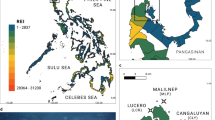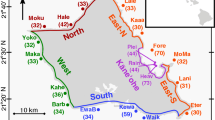Abstract
The hypothesis that intraspecific variation in coral bleaching is a result of the distribution of bleaching-susceptible clonal genotypes (genets) was addressed using photoquadrats recorded during the 1987 Caribbean bleaching event on a reef dominated by Montastraea annularis (Morphotype I), together with manipulative experiments with Porites porites. Nearest-neighbor analysis showed that bleached colonies (ramets) of M. annularis at 10 m depth had a high probability (0.80) of having a nearest bleached neighbor of the same genet rather than a bleached ramet of a different genet. Furthermore, the frequency distributions of bleached ramets of M. annularis in the photoquadrats was significantly different from a Poisson distribution, suggesting that bleached ramets were aggregated on the reef. Manipulative experiments with P. porites from 15 m depth showed that some genets were more susceptible to thermal bleaching than others, since three genets had significantly different rates of zooxanthellae loss when exposed to elevated temperatures in tanks receiving irradiances similar to those found in situ. These results suggest that the in situ patchy distribution of bleached ramets could correspond to the distribution of certain genets, and that adjacent genets can exhibit sufficiently different phenotypes to account for intraspecific variation in bleaching. Further studies of genet-specific coral bleaching may provide valuable insights into the causes and consequences of bleaching.
Similar content being viewed by others
References
Brown BE (1987) Worldwide death of corals-natural cyclical events or man-made pollution. Mar Pollut Bull 18:9–13
Brown BE, Tudhope AW, Le Tissier MDA, Scoffin TP (1991) A novel mechanism for iron incorporation into coral skeletons. Coral Reefs 10:211–215
Buddemeier RW, Fautin DG (1993) Coral bleaching as an adaptive mechanism. BioSci 43:320–326
Connell JH (1973) Population ecology of reef-building corals. In: Jones OA, Endean R (eds) Biology and geology of coral reefs. Vol. 2. Academic Press, New York, NY, pp 205–245
D'Elia CF, Buddemeier RW, Smith SV (1991) Workshop on coral bleaching coral reef ecosystems and global change: report of proceedings. Maryland Sea Grant College publication No UM-SG-TS-91-03. University of Maryland, College Park, Md
Edmunds PJ (1993) Evidence that patterns of coral bleaching may reflect the distribution of bleaching susceptible coral clones. Am Zool 33:p. 18A
Edmunds PJ, Witman JD (1991) Effect of Hurricane Hugo on the primary framework of a reef along the south shore of St. John, US Virgin Islands. Mar Ecol Prog Ser 78:201–204
Gates RD (1990) Seawater temperature and sublethal coral bleaching in Jamaica. Coral Reefs 8:193–197
Gates RD, Baghdasarian G, Muscatine L (1992) Temperature stress causes host cell detachment in symbiotic cnidarians: implications for coral bleaching. Biol Bull mar biol Lab, Woods Hole 182:324–332
Gleason DF, Wellington GM (1993) Ultraviolet radiation induces coral bleaching: evidence from field experiments. Nature, Lond 365:836–837
Glynn PW (1990) Coral mortality and disturbances of coral reefs in the tropical eastern Pacific. In: Glynn PW (ed) Global ecological consequences of the 1982–1983 El Niño-Southern Oscillation. Elsevier, Amsterdam, pp 55–126
Heyward AJ, Collins JD (1985) Fragmentation in Montipora ramosa: the genet and ramet concept applied to a reef coral. Coral Reefs 4:35–40
Highsmith RC (1982) Reproduction by fragmentation in corals. Mar Ecol Prog Ser 7:207–226
Hoegh-Guldberg O, McCloskey LR, Muscatine L (1987) Expulsion of zooxanthellae by symbiotic cnidarians from the Red Sea. Coral Reefs 5:201–204
Hoegh-Guldberg O, Smith GJ (1989) The effect of sudden changes in temperature, light and salinity on the population density and export of zooxanthellae from the reef corals Stylophora pistillata Esper and Seriatopora hystrix Dana. J exp mar Biol Ecol 129:279–303
Hoeksema BW (1991) Control of bleaching in mushroom coral populations (Scleractinia: Fungiidae) in the Java Sea: stress tolerance and interference by life history strategy. Mar Ecol Prog Ser 74:225–237
Hughes RN (1989) A functional biology of clonal animals. Chapman & Hall, New York
Hughes TP, Jackson JBC (1985) Population dynamics and life histories of foliaceous corals. Ecol Monogr 55:141–166
Hunter CL (1985) Assessment of clonal diversity and population structure of Porites compressa (Cnidaria, Scleractinia). Proc 5th int coral Reef Congr 6:69–74. [Gabrié C et al. (eds) Antenne Museum-EPHE, Moora, French Polynesia]
Iglesias-Prieto R, Matta JL, Robins WA, Trench RK (1992) Photosynthetic response to elevated temperature in the symbiotic dinoflagellate Symbiodinium microadriaticum in culture. Proc natn Acad Sci USA 89:10302–10305
Johannes RE, Wiebe WJ (1970) Method for determination of coral tissue biomass and composition. Limnol Oceanogr 15:822–824
Jokiel PL, Coles SL (1990) Response of Hawaiian and other Indo-Pacific reef corals to elevated temperature. Coral Reefs 8:155–162
Kinzie RA III (1993) Effects of ambient levels of solar ultraviolet radiation on zooxanthellae and photosynthesis of the reef coral Montipora verrucosa. Mar Biol 116:319–327
Knowlton N, Weil E, Weigt LA, Guzman HM (1992) Sibling species in Montastraea annularis, coral bleaching and the coral climate record. Science, NY 255:330–334
Lang JC, Lasker HR, Gladfelter EH, Hallock P, Jaap WC, Losada FJ, Muller RG (1992) Spatial and temporal variability during periods of “recovery” after mass bleaching on Western Atlantic coral reefs. Am Zool 32:696–706
Lesser MP, Stochaj WR, Tapley DW, Shick JM (1990) Bleaching in coral reef anthozoans: effect of irradiance, ultraviolet radiation, and temperature on the activities of protective enzymes against active oxygen. Coral Reefs 8:225–232
Marsh JA (1970) Primary productivity of reef-building calcareous red algae. Ecology 51:225–263
McCloskey LR, Muscatine L (1984) Production and respiration in the Red Sea coral Stylophora pistillata as a function of depth. Proc R Soc (Ser B) 222:215–230
Muscatine L, Grossman D, Doino J (1991) Release of symbiotic algae by tropical sea anemones and corals after cold shock. Mar Ecol Prog Ser 77:233–243
Ogden J, Wicklund R (1988) Mass bleaching of coral reefs in the Caribbean: a research strategy. National Undersea Research Program Research Report No. 88-2. US Department of Commerce, National Ocoanic and Atmospheric Administration, Washington
Oliver J (1985) Recurrent seasonal bleaching and mortality of corals on the Great Barrier Reef. Proc 5th int coral Reef Congr 4:201–206 [Gabrié C et al. (eds) Antenne Museum-EPHE, Moorea, French Polynesia
Porter JW, Fitt WK, Spero HJ, Rogers CS, White MW (1989) Bleaching in reef corals: physiological and stable isotopic responses. Proc natn Acad Sci USA 86:9342–9346
Potts DC (1984) Natural selection in experimental populations of reef-building corals (Scleractinia). Evolution 38:1059–1078
Roberts L (1988) Corals remain baffling. Science, NY 239:p. 256
Rowan R, Powers DA (1991) A molecular genetic classification of zooxanthellae and the evolution of animal-algal symbioses. Science, NY 251:1348–1351
Stoddart JA (1984) Genetical structure within populations of the coral Pocillopora damicornis. Mar Biol 81:19–30
Tomascik T, Sander F (1987) Effects of eutrophication on reef-building corals. III. Reproduction of the reef-building coral Porites porites. Mar Biol 94:77–94
Williams EH, Williams LB (1990) The world-wide coral reef bleaching cycle and related sources of coral mortality. Atoll Res Bull 335:1–71
Willis BL, Ayre DJ (1985) Asexual reproduction and genetic determination of growth form in the coral Pavona cactus: biochemical genetic and immunogenic evidence. Oecologia 65:516–525
Woodley JD (1988) Coral Bleaching in Jamaica, 1987. In: Ogden J, Wicklund R (eds) Mass bleaching of coral reefs in the Caribbean: a research strategy. National Undersea Researh Program Research Report No. 88-2. US Department of Commerce, National Oceanic and Atmospheric Administration, Washington, pp 33–34
Yonge CM, Nicholls AG (1931) Studies on the physiology of corals. V. The effect of starvation in light and in darkness on the relationship between corals and zooxanthellae. Scient Rep Gt Barrier Reef Exped 1:177–211
Zar JH (1984) Biostatistical analysis. 2nd edn. Prentice-Hall, Englewood Cliffs, New Jersey
Author information
Authors and Affiliations
Additional information
Communicated by M. F. Strathmann, Friday Harbor
Rights and permissions
About this article
Cite this article
Edmunds, P.J. Evidence that reef-wide patterns of coral bleaching may be the result of the distribution of bleaching-susceptible clones. Marine Biology 121, 137–142 (1994). https://doi.org/10.1007/BF00349482
Received:
Accepted:
Issue Date:
DOI: https://doi.org/10.1007/BF00349482




